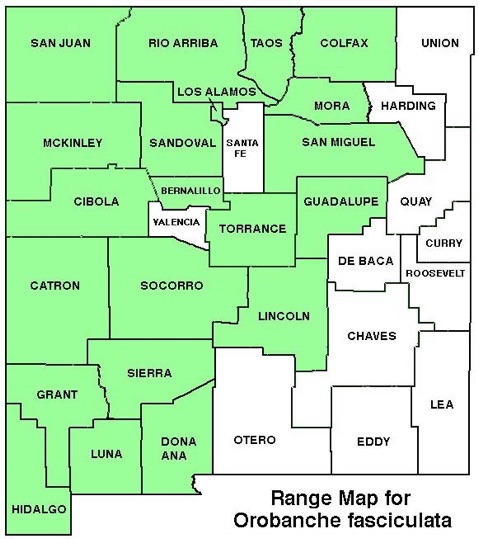WILDFLOWERS OF NEW MEXICO

These root parasites, primarily on sagebrush and other Artemisia species, have as much stem underground, where they attach to host plant roots, as above ground. The stem branches at or below ground level into clusters of 4–12 thin, hairy, erect flower stalks (pedicels). Note each yellowish to pinkish-purple pedicel, 1–6-inches tall, has one similarly colored, tubular flower.
FLOWERS: May–July. Flowers tubular, 5/8–1 1/8-inches long (15–30 mm), hairy, spreading open with 5 rounded lobes streaked with dark lines, surfaces hairy. The hairy calyx tube holding the petals is 1/4–1/2-inch long (7–11 mm) with slender, pointed lobes shorter than or equal to the calyx base.
LEAVES: Absent, the parasitic plant does not photosynthesize. Note the 6–10 small, leaf-like bracts clustered around the base of the flowering pedicels.
HABITAT: Sandy, gravelly, clay soils, usually with Artemisia species; desert grasslands and scrub, pinyon-juniper woodlands.
ELEVATION: 5,400–8,000 feet.
RANGE: Widespread in Rocky Mountain states and westward.
SIMILAR SPECIES: The look-alike Naked Broomrape, O. uniflora, also parasitic on Artemisia in western NM, has clusters of only 1–3 flowering pedicels rising from each underground stem and a calyx tube beneath the petals with lobes longer than the tube, and fewer than 6 bracts at the base of the flower pedicel. Other broomrapes have numerous flowers on a crowded spike.
NM COUNTIES: Western 2/3 of NM (absent on eastern plains) in mid-elevation sagebrush and Artemisia communities: Bernalillo, Catron, Cibola, Colfax, Dona Ana, Grant, Guadalupe, Hidalgo, Lincoln, Los Alamos, Luna, McKinley, Mora, Rio Arriba, San Juan, San Miguel, Sandoval, Sierra, Socorro,Taos, Torrance..

CLUSTERED BROOMRAPE
OROBANCHE FASCICULATA
Broomrape Family (Orobanchaceae)
Annual/Perennial herb; root parasite

THE CONTENTS OF THIS WEBSITE ARE COPYRIGHTED AND CANNOT BE USED
WITHOUT PERMISSION OF GEORGE OXFORD MILLER




• Calyx lobes about equal to the calyx tube (upper arrow).
• Only one flower per pedicel (middle arrow).
• 1–6 pedicels sprout from mostly underground stem (lower arrow).


Flower and pedicel color varies from yellowish to pinkish purple.


EMAIL ME